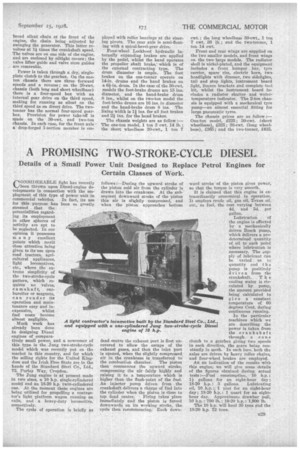A PROMISING TWO-STROKE-CYCLE DIESEL,
Page 13

If you've noticed an error in this article please click here to report it so we can fix it.
Details of a Small Power Unit Designed to Replace Petrol Engines for Certain Classes of Work.
CONSIDERABLE light has recently been thrown upon Diesel-engine developments in connection with the employment of this type of power unit in
commercial vehicles. In fact, its use for this purpose has been so greatly stressed that the potentialities regarding its employment in other spheres of activity are apt to be neglected. In our opinion it possesses man y excellent points which merit close attention being given to its use upon road tractors, agricultural appliances, light locomotives, etc, where the extreme simplicity of the two-stroke-cycle pattern, which requires no valves, camshaft, carburetter or magneto, can render its operation and maintenance easy and in expensive, whilst fuel costs become almost negligible.
Much work has already been done in designing Diesel engines of comparatively small power, and a newcomer of this type is the Jung two-stroke-cycle model which was recently put on the market in this country, and for which the selling rights for the United Kingdom and the Irish Free State are in the hands of the Standard Steel Co., Ltd., 72, Purley Way, Croydon.
The Jung engine is at present made in two sizes, a 10 h.p. single-cylindered model and en 18-20 h.p. twin-cylindered one. At the moment these engines are being utilized for propelling a contractor's light platform wagon running on rails, and a heavy-duty locomotive, respectively.
The cycle of operation is briefly es follows :—During the upward stroke of the piston cold air from the cylinder is drawn into the crankcase. At the subsequent downward stroke of the piston this air is slightly compressed, and when the piston approaches bottom dead centre the exhaust port is first uncovered to allow the escape of the exhaust gases, and then the inlet port is opened, when the slightly compressed air in the crankcase is transferred to the combustion Chamber. The piston then commences the upward stroke, compressing the air fairly hi,ghly and raising it to a temperature which is higher than the flash-point of the fuel. An injector pump driven from the crankshaft delivers a charge of feel into the cylinder when the piston is close to top, dead centre. Firing takes place immediately and the piston is forced downwards on its working stroke, the cycle then recommencing. Each down• ward stroke ' of the piston gives power, so that the torque is very smooth.
It is claimed that this engine is extraordinarily economical in operation. It employs crude oil, gas oil, Texas oil, etc., as fuel, the cost varying between 4d. and 5d. per gallon.
Lubrication of the engine is effected by a mechanically driven Bosch Pullin, which delivers a predetermined quantity of oil to each point' where lubrication is necessary. The supply of lubricant can be varied as to quantity and t h e pump is positively driven from the
crankshaft. T h e cooling water is circulated by pump, the amount provided being calculated to give a constant temperature of 60 degrees Cent, during continuous running.
In the particular machines which we are describing the power is taken from the crankshaft through a cone clutch to a gearbox giving two speeds in each direction, the gears being constantly in mesh. In each loco, both the axles are driven by heaVy roller chains, and four-wheel brakes are employed.
An an indication of the results -with this engine; We will give some "details of the figures obtained during actual tests :—Fuel consumption, 10 h.p.: 11 gallong. for an eight-hour day ;
18-20 h.p.: 3' gallons. Lubricating oil, 10 h.p.: 1 pint for nn eight-hour day ; 18-20 h.p.: 1 quart for an eighthour day. Approximate drawbar pull, 10 h.p.: 790 lb.; 19-20 h.p. : 1,900 lb.
The 10 h.p. Will haul 30 tons and the 18-20 h.p. 72 tons.
































